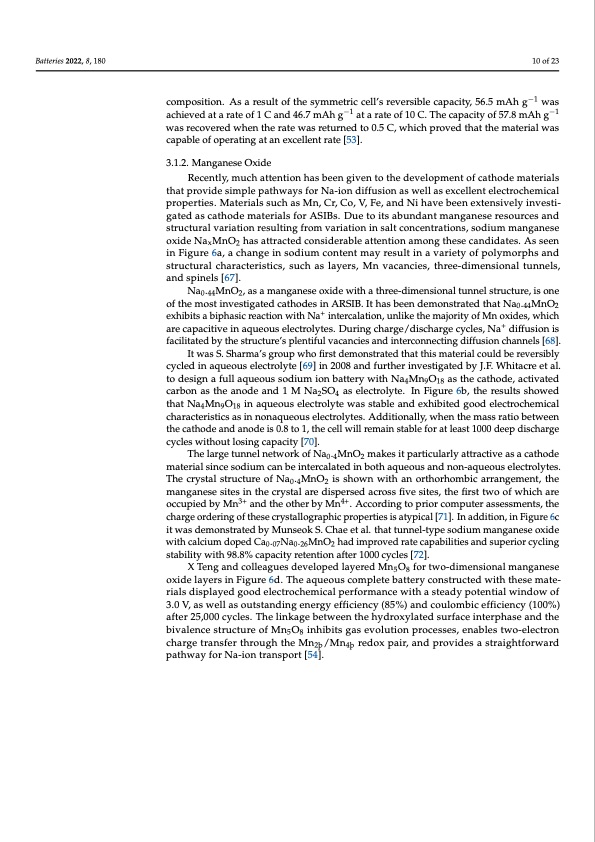
PDF Publication Title:
Text from PDF Page: 010
Batteries 2022, 8, 180 10 of 23 composition. As a result of the symmetric cell’s reversible capacity, 56.5 mAh g−1 was achieved at a rate of 1 C and 46.7 mAh g−1 at a rate of 10 C. The capacity of 57.8 mAh g−1 was recovered when the rate was returned to 0.5 C, which proved that the material was capable of operating at an excellent rate [53]. 3.1.2. Manganese Oxide Recently, much attention has been given to the development of cathode materials that provide simple pathways for Na-ion diffusion as well as excellent electrochemical properties. Materials such as Mn, Cr, Co, V, Fe, and Ni have been extensively investi- gated as cathode materials for ASIBs. Due to its abundant manganese resources and structural variation resulting from variation in salt concentrations, sodium manganese oxide NaxMnO2 has attracted considerable attention among these candidates. As seen in Figure 6a, a change in sodium content may result in a variety of polymorphs and structural characteristics, such as layers, Mn vacancies, three-dimensional tunnels, and spinels [67]. Na0.44MnO2, as a manganese oxide with a three-dimensional tunnel structure, is one of the most investigated cathodes in ARSIB. It has been demonstrated that Na0.44MnO2 exhibits a biphasic reaction with Na+ intercalation, unlike the majority of Mn oxides, which are capacitive in aqueous electrolytes. During charge/discharge cycles, Na+ diffusion is facilitated by the structure’s plentiful vacancies and interconnecting diffusion channels [68]. It was S. Sharma’s group who first demonstrated that this material could be reversibly cycled in aqueous electrolyte [69] in 2008 and further investigated by J.F. Whitacre et al. to design a full aqueous sodium ion battery with Na4Mn9O18 as the cathode, activated carbon as the anode and 1 M Na2SO4 as electrolyte. In Figure 6b, the results showed that Na4Mn9O18 in aqueous electrolyte was stable and exhibited good electrochemical characteristics as in nonaqueous electrolytes. Additionally, when the mass ratio between the cathode and anode is 0.8 to 1, the cell will remain stable for at least 1000 deep discharge cycles without losing capacity [70]. The large tunnel network of Na0.4MnO2 makes it particularly attractive as a cathode material since sodium can be intercalated in both aqueous and non-aqueous electrolytes. The crystal structure of Na0.4MnO2 is shown with an orthorhombic arrangement, the manganese sites in the crystal are dispersed across five sites, the first two of which are occupied by Mn3+ and the other by Mn4+. According to prior computer assessments, the charge ordering of these crystallographic properties is atypical [71]. In addition, in Figure 6c it was demonstrated by Munseok S. Chae et al. that tunnel-type sodium manganese oxide with calcium doped Ca0.07Na0.26MnO2 had improved rate capabilities and superior cycling stability with 98.8% capacity retention after 1000 cycles [72]. X Teng and colleagues developed layered Mn5O8 for two-dimensional manganese oxide layers in Figure 6d. The aqueous complete battery constructed with these mate- rials displayed good electrochemical performance with a steady potential window of 3.0 V, as well as outstanding energy efficiency (85%) and coulombic efficiency (100%) after 25,000 cycles. The linkage between the hydroxylated surface interphase and the bivalence structure of Mn5O8 inhibits gas evolution processes, enables two-electron charge transfer through the Mn2þ/Mn4þ redox pair, and provides a straightforward pathway for Na-ion transport [54].PDF Image | Aqueous Rechargeable Sodium-Ion Batteries Hydrogel

PDF Search Title:
Aqueous Rechargeable Sodium-Ion Batteries HydrogelOriginal File Name Searched:
batteries-08-00180-v2.pdfDIY PDF Search: Google It | Yahoo | Bing
Salgenx Redox Flow Battery Technology: Salt water flow battery technology with low cost and great energy density that can be used for power storage and thermal storage. Let us de-risk your production using our license. Our aqueous flow battery is less cost than Tesla Megapack and available faster. Redox flow battery. No membrane needed like with Vanadium, or Bromine. Salgenx flow battery
| CONTACT TEL: 608-238-6001 Email: greg@salgenx.com | RSS | AMP |